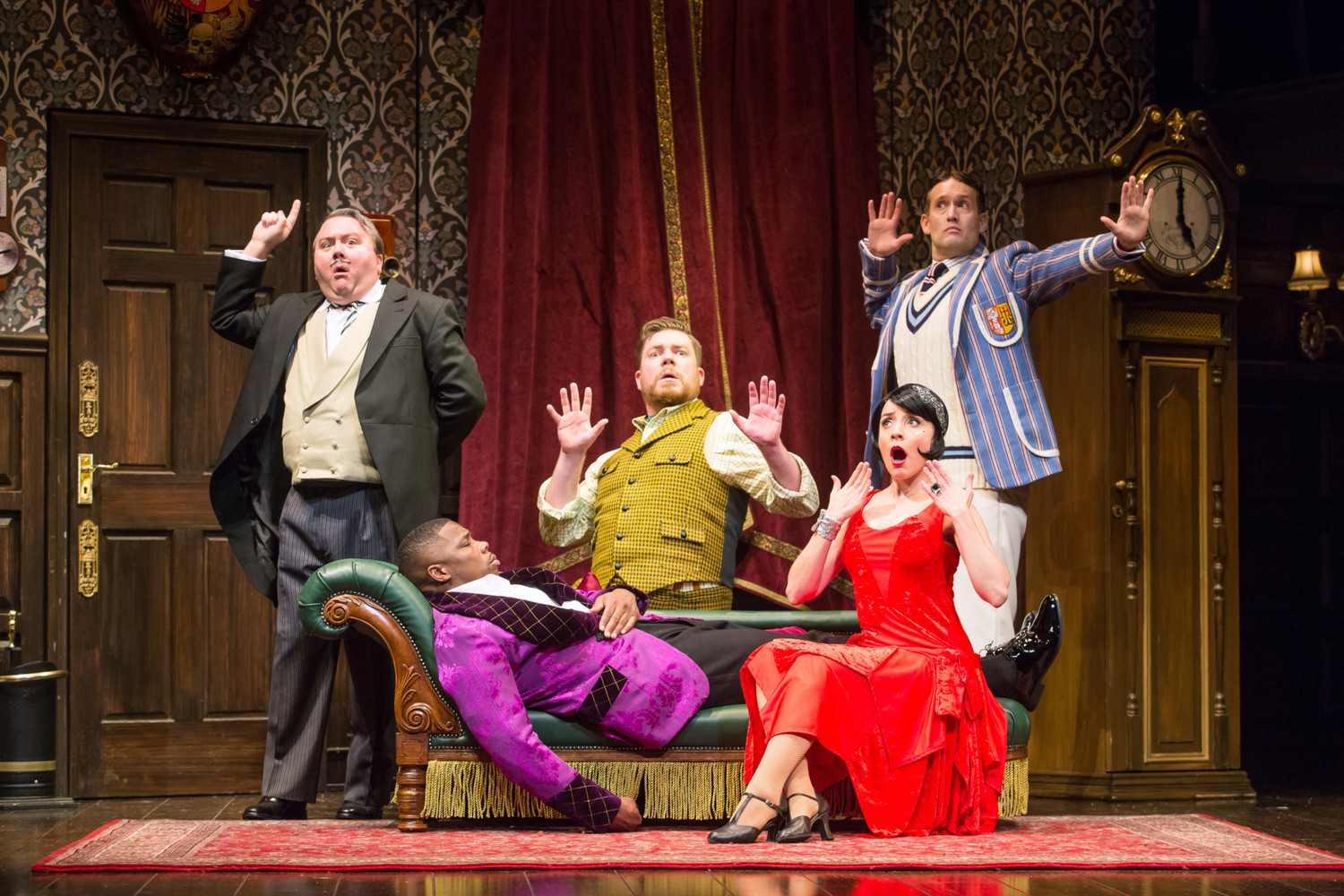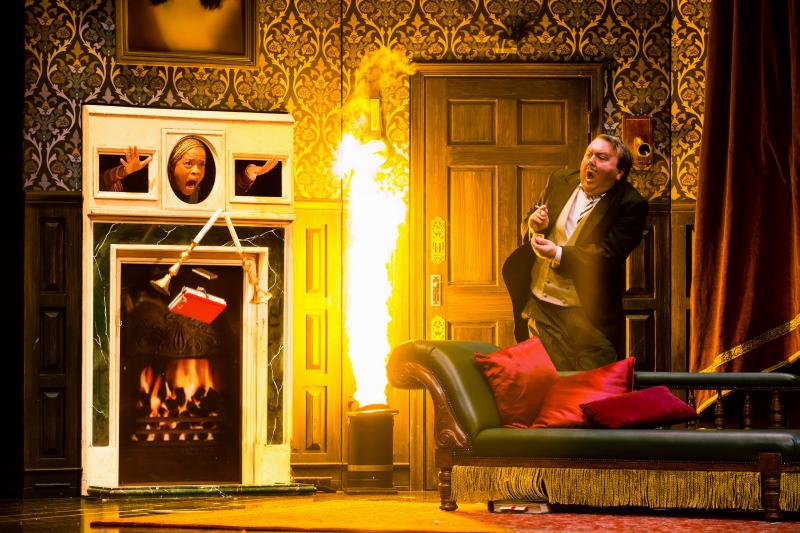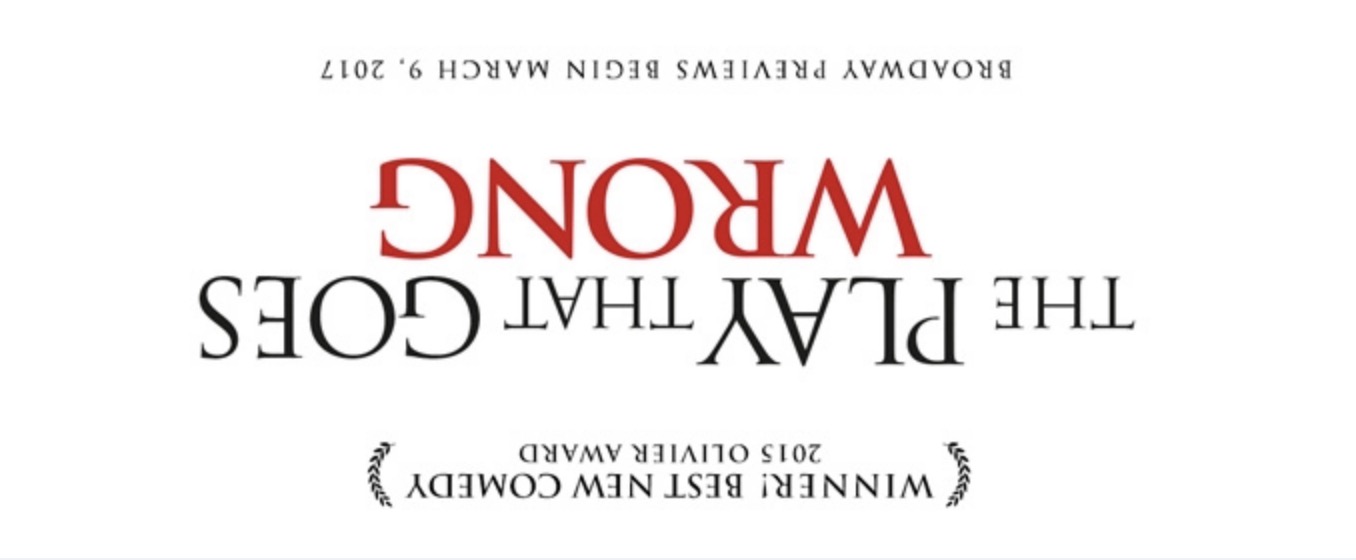Review: THE PLAY THAT GOES WRONG at The Kennedy Center

My performance career came to an end the summer of my senior year when I was in the ensemble of Thoroughly Modern Millie. The Stagedoor Manor production featured a high-intensity tap sequence perched atop rolling desks. We were typists. You know the scene. Opening night, I rolled enthusiastically onto the stage, immediately turtled onto my back and, realizing I couldn't right myself, executed the entire scene tapping into the air. Of course, it lives on in the DVD sent home to parents, but who has a DVD player anymore?
Having experienced this live theater humiliation in front of what were surely dozens of peers, I cannot fathom willingly undertaking the escalating catastrophes of The Play that Goes Wrong night after night. The potential for disaster is, of course, the masochistic thrill of live theater. Anything can happen but how often do you actually see anything go wrong in a play? Yet, we are all tethered by this morbid curiosity for the possibility that things could at any moment fall apart.
Here for our malevolent indulgence is the perfect fodder for the cultural devil on our shoulder. The Play that Goes Wrong has been lauded for its comedy, but I found myself more often gasping than laughing. The show begins with a string of gimmicks, including the ultimate stunt of starting the show before the show. Tripping over castmates and falling picture frames deserve a few chuckles, but the lighter laughs soon give way to true acrobatics. A Cirque du Soleil of disaster unfolds and I am baffled as to how the entire cast avoids serious injury. I made the mistake of believing I had the formula figured out halfway through the first act, just in time for the company to prove me wrong. Wild quickly gets wilder.
The setting is a college production of The Murder at Haversham, an Agatha Christie style murder mystery. Shoddy scenery interrupts the show, but here is the most astonishing part of The Play that Goes Wrong. They never stop performing the Haversham script. I will try to capture just how impressive the actors are, but it simply must be seen to be appreciated. By the end of the play, there is a fully realized arc of rival performers, a frustrated director, an irritated crew, and a glutton for attention, but they never get to speak an honest word from their characters. As the collapsing play rattles onward, they have to act through and beyond their circumstances. Imagine if you could only express yourself by reading Hamlet aloud each day. That is the challenge that faces this cast as they convey characters through the vessel of another character.
.jpg)
Please pardon me while I consult my playbill closely. There is a playbill within the playbill for the play within the play. Most memorable among the performers is Peyton Crim who plays Robert playing Thomas. His talent is apparent in the first act, but past intermission he is an absolute marvel. His unflappable demeanor is salty. Crim grapples in fits and feats that literally defy gravity and I am still trying to untangle my brain over one death-defying sequence that seemed to smash OSHA regulations.
Scott Cote as Dennis as Perkins carries most of the laughs. It isn't easy playing dumb, but Cote commits. He's an anxiety-riddled player who acts as the butler. He should have a fairly innocuous role in the Haversham play but manages to mess it up regularly. He's the catalyst for the majority of the confusion and has to constantly swim away from the pack. Dennis or Perkins or whoever may seem bumbling, but Cote's execution is exact.
Angela Grovey and Brandon J. Ellis are saddled with the audience participation and they actually make it fun. Interacting with a crowd, particularly on tour where every town can have a different personality, is a gamble. Smart-aleck foils or boring curmudgeons can ruin a good bit, but the duo played on to great laughter and cheers.

Evan Alexander Smith as Chris/Inspector Carter is endearing and energetic. When he begs the audience to stop laughing, I nearly felt guilty and had to reorient myself to remember in reality, he plans for and plays into the laughs. Ned Noyes as Max/Cecil is a goofy delight as the only member who relishes the show's dissolving integrity. Yaegel T. Welch as Jonathan/Charles is greatly underused but gets us off on the right foot - er - hand and has some show-stopping moments. Jamie Ann Romero as Sandra/Florence adds a lovely dash of spunk as the sincere and cunning leading lady.
Not that anyone needed my confirmation, but Nigel Hook absolutely deserved his Tony award for set design. The entire production looks like an insurance nightmare, but all of the principal cast were appearing in their roles, so they must have survived this long at least. Hat tip to Matt Schrieber who must be medicating mad stress headaches as the stage manager of a play where the point is to have the wrong prop at the right time.
As a retired member of a high school theatrical ensemble, watching the show nearly caused me palpitations, but that is largely the point. I played right into the illusion that everything was falling apart. If it ever truly did, it apparently wasn't anything the cast couldn't get out of. Most likely, nothing will go wrong except absolutely everything which is exactly what they promise.
The Play that Goes Wrong appears at the Kennedy Center through January 6.
Featured Image: The Play That Goes Wrong National Tour. Photo by Jeremy Daniel
Reader Reviews

Videos


